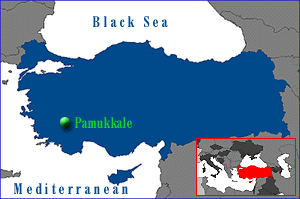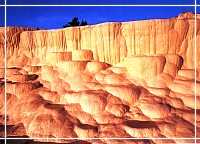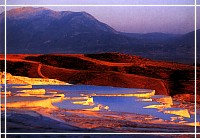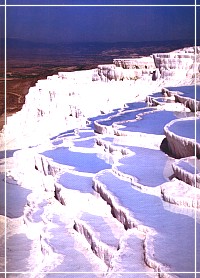PAMUKKALE
 Until forty or fifty years ago, Pamukkale was a place where travelers who
happened to pass by found peace and tranquillity and the opportunity for quiet meditation
by the side of the sacred spring that still lies exposed, amid the few ancient columns and
in the deep silence of the tombs that lay scattered over the countryside to the west and
extended out towards the surrounding hills. In spite of the doubtful merits of present-day
developments, and in spite of all the ugly building construction that has taken place, the
seething crowds, the noise and pollution, one can still confidently assert that Pamukkale
has lost nothing of its former attractions. Until forty or fifty years ago, Pamukkale was a place where travelers who
happened to pass by found peace and tranquillity and the opportunity for quiet meditation
by the side of the sacred spring that still lies exposed, amid the few ancient columns and
in the deep silence of the tombs that lay scattered over the countryside to the west and
extended out towards the surrounding hills. In spite of the doubtful merits of present-day
developments, and in spite of all the ugly building construction that has taken place, the
seething crowds, the noise and pollution, one can still confidently assert that Pamukkale
has lost nothing of its former attractions.
 Pamukkale
is located in the Inner Aegean region at a distance of 20 km from the town of Denizli.
This lovely, rapidly developing district in the Menderes valley, which enjoys a temperate
climate over the greater part of the year, has all the conditions required for an ideal
touristic resort.The tectonic movements that took place in the fault depression of the
Menderes river basin gave rise to the emergence of a number of very hot springs, and it is
the water from one of these springs, with its large mineral content, chalk in particular,
that has created the natural wonder now known as Pamukkale, Cotton Fortress or
Baumwollenschloss, a very appropriate name for such a phenomenon... Pamukkale
is located in the Inner Aegean region at a distance of 20 km from the town of Denizli.
This lovely, rapidly developing district in the Menderes valley, which enjoys a temperate
climate over the greater part of the year, has all the conditions required for an ideal
touristic resort.The tectonic movements that took place in the fault depression of the
Menderes river basin gave rise to the emergence of a number of very hot springs, and it is
the water from one of these springs, with its large mineral content, chalk in particular,
that has created the natural wonder now known as Pamukkale, Cotton Fortress or
Baumwollenschloss, a very appropriate name for such a phenomenon...
 You
may approach Pamukkale by the main roads marked on your map, but there are also other
ways, according to the direction from which you are coming. For example, if you approach
from the West you can branch off to the left at the sign shortly after Sarayk�y�.This
will give you the opportunity of seeing and getting to know quite a few very interesting
Western Anatolian villages.On approaching Pamukkale, whether you choose the route through
these villages or arrive by the Denizli road you will be confronted by one of the most
remarkable landscapes to be seen anywhere in Turkey.The first thing you will see is a rock
platform over 100 m in height rising up from the plain. The slopes of this hill, which
look from a distance like a great white speck, are covered with large numbers of pools and
terraces.As you come nearer, you will begin to see this natural phenomenon, which
resembles a frozen waterfall, in greater detail. You
may approach Pamukkale by the main roads marked on your map, but there are also other
ways, according to the direction from which you are coming. For example, if you approach
from the West you can branch off to the left at the sign shortly after Sarayk�y�.This
will give you the opportunity of seeing and getting to know quite a few very interesting
Western Anatolian villages.On approaching Pamukkale, whether you choose the route through
these villages or arrive by the Denizli road you will be confronted by one of the most
remarkable landscapes to be seen anywhere in Turkey.The first thing you will see is a rock
platform over 100 m in height rising up from the plain. The slopes of this hill, which
look from a distance like a great white speck, are covered with large numbers of pools and
terraces.As you come nearer, you will begin to see this natural phenomenon, which
resembles a frozen waterfall, in greater detail.
 From
the edge of every terrace and every step in this fascinating natural phenomenon that has
gradually formed throughout the ages hang brilliantly white stalactites, and you can hear
the joyful splashing of the waters of the hot springs as they cascade down over slopes
where their flow is impeded only by clumps of oleanders.The temperature of the water
forming the travertines, which issues from the hot springs on the hills above, falls to
around 33 C� lower down.On emerging to the surface, the solution of calcium-carbonate in
the spring water decomposes into carbon dioxide, calcium carbonate and water. The carbon
dioxide is released into the air while the calcium carbonate separates off from the water
to form a grayish-white limestone sediment.The beds of the water-courses are filled up
with these limestone deposits and the water, confronted with these obstacles, splits up
into several branches.The water flows over the slopes into pools, the small basins
surrounding them and finally into the fields below.It is in this way that these terraces
over 100 m in height composed of layers of the accumulated limestone sediment have been
gradually formed in the course of the ages. As the limestone sediment reaches a certain
level the water accumulates in pools and, as these pools fill up, overflows into smaller
pools in the vicinity and from these flowsinto the small hollows and depressions around
them.The limestone layers in the pools rise up in steps, one above the other, and the
continual flow of water keeps this process in operation.The stalactites form one of the
most important features in the landscape. From
the edge of every terrace and every step in this fascinating natural phenomenon that has
gradually formed throughout the ages hang brilliantly white stalactites, and you can hear
the joyful splashing of the waters of the hot springs as they cascade down over slopes
where their flow is impeded only by clumps of oleanders.The temperature of the water
forming the travertines, which issues from the hot springs on the hills above, falls to
around 33 C� lower down.On emerging to the surface, the solution of calcium-carbonate in
the spring water decomposes into carbon dioxide, calcium carbonate and water. The carbon
dioxide is released into the air while the calcium carbonate separates off from the water
to form a grayish-white limestone sediment.The beds of the water-courses are filled up
with these limestone deposits and the water, confronted with these obstacles, splits up
into several branches.The water flows over the slopes into pools, the small basins
surrounding them and finally into the fields below.It is in this way that these terraces
over 100 m in height composed of layers of the accumulated limestone sediment have been
gradually formed in the course of the ages. As the limestone sediment reaches a certain
level the water accumulates in pools and, as these pools fill up, overflows into smaller
pools in the vicinity and from these flowsinto the small hollows and depressions around
them.The limestone layers in the pools rise up in steps, one above the other, and the
continual flow of water keeps this process in operation.The stalactites form one of the
most important features in the landscape.
 With
the formation of the layers and the emergence of steps and terraces one above the other,
the water leaves the limestone deposit behind it and drips down in the form of
stalactites, as in the Damlata� caverns.The calcium oxide in the water adds to the
thickness of the white layers and widens the terraces, producing pools in fantastic shapes
reminiscent of oyster shells or flower petals, while the small amount of sulphur and iron
oxide produces stripes of yellow, red and green over the white of the limestone. Any
object left in the water at Pamukkale will take on a coating of limestone within a very
few days. Now, as in the olden days, the water flows through open channels, and in cold
weather you can see columns of mist dancing over the surface.Although the water flowing
from the hot springs on the southern slopes of �alda� rapidly loses heat during its flow
through these open channels it is still hot enough to make it possible for one to bathe
throughout six months of the year in the open-air swimming pools in the motels and on the
terraces. With
the formation of the layers and the emergence of steps and terraces one above the other,
the water leaves the limestone deposit behind it and drips down in the form of
stalactites, as in the Damlata� caverns.The calcium oxide in the water adds to the
thickness of the white layers and widens the terraces, producing pools in fantastic shapes
reminiscent of oyster shells or flower petals, while the small amount of sulphur and iron
oxide produces stripes of yellow, red and green over the white of the limestone. Any
object left in the water at Pamukkale will take on a coating of limestone within a very
few days. Now, as in the olden days, the water flows through open channels, and in cold
weather you can see columns of mist dancing over the surface.Although the water flowing
from the hot springs on the southern slopes of �alda� rapidly loses heat during its flow
through these open channels it is still hot enough to make it possible for one to bathe
throughout six months of the year in the open-air swimming pools in the motels and on the
terraces.
Places to visit:
Related Links:
Photographs by:Semsi Guner,Erdal
Yazici,Gungor Ozsoy,Haluk Ozozlu,Firdevs Sayilan,donence Diabank |
|

